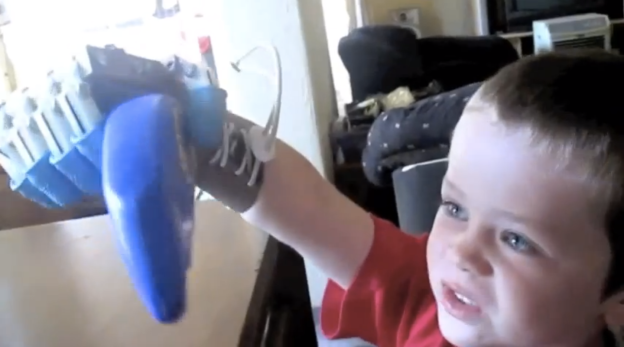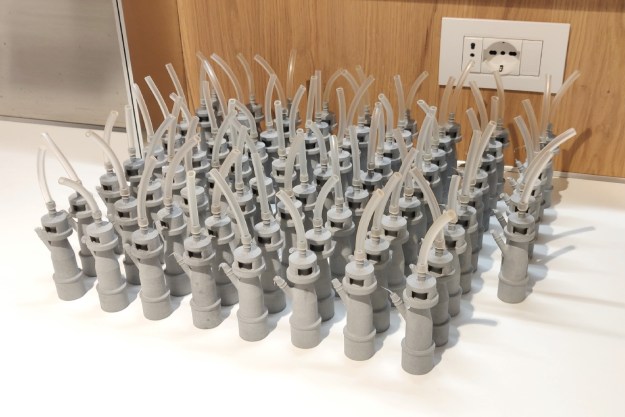Two years ago, Ivan Owen was a hobbyist, accordion player and craftsman who built medieval armor, metal costumes, and chain jewelry, which he sold through his Etsy shop, ChainCrafts. When he hacked together an oversized mechanical hand as an experiment and posted a 49-second clip on YouTube, he had no idea the course of his life was about to change forever.
The clip caught the attention of Richard Van As, a South African engineer who recently lost his fingers in a woodworking accident, the hand began the transformation from simple toy to a life-changing tool. Together, they began tele-collaborating from 10,000 miles apart, working across a 10-hour time difference to create 3D-printed prototypes of a “robohand” to aide those who share Van As’ struggle. The final product landed in the hand of Liam, a five-year-old South African boy who was born with Amniotic Band Syndrome that left him with no fingers on one hand. Plans for the prototype can also be found on Thingiverse at no cost to users, for those interested in creating their own.
We chatted with Owen on his Internet collaboration story, and how one fateful YouTube clip may have changed the future of medicine.
Digital Trends: What was it like working remotely with Richard on something so complex?
Owen: Richard and I are equal design partners, which made the project all the more possible. He has a lot of insight because he’s a former machinist, and I help with the design. We communicated mostly via Skype and email, until one day Richard’s friend kindly donated his frequent flyer miles to help us build the prototype together. With that, I went to South Africa for the first time last November, so it had been a little over a year into the project until I met Richard in person.
DT: Why did you decide to 3D print the hand?
Owen: Before last year, I didn’t really know anything about 3D printing, but we explored ways to provide [the robohand] at no costs to users. A friend of mine suggested MakerBot, and they sent us two machines for us. Ultimately, 3D printing gives us the ability to use small-scale production – the plastic is very low cost, strong, and lightweight.
DT: Was there a difficult learning curve?
Owen: I’ve found that 3D Printing made a lot more sense than I initially thought it would. I have a background in computer programming and industrial automation from my past work, so I used an open-source program to help design. It takes a bit to figure out the scripting, but it’s really just a process of manipulating the 3D form. As long as you design your files correctly, they print quite well. The main challenge is figuring out the best layout to correctly orient the object so you can printing and get the max amount of strength.

DT: Why have you chosen not to monetize on the robohand?
Owen: I used to work in medical reception. From my experience, I found it to be very frustrating that insurance does not cover everything. High costs of medical services make it hard for people to gain access. Richard is the example of that – he lost his fingers and the prosthetics he looked into cost so much that it was impossible for him to obtain them. If we can find a way to make it more accessible, we should to make it more freely available. We want to provide something that adds functionality to one’s body and improves quality of life.
DT: It’s pretty wild that one YouTube clip brought this collaboration together, huh?
Owen: It’s unreal the age of tech right now! People around the globe can communicate with each other for free, and a child in South Africa can get a mechanical hand despite his family’s income. Technology makes to easier for people to jump in and solve problems without a lot of money.
DT: We’re curious: How exactly does the robohand work and what was the inspiration behind it?
Owen: We did a lot of research about tech in the 1800s that used a series of cables and pulleys to activate movements. Essentially, the robohand can recognize muscle movements under the back of one’s hand and uses the pulleys to flex the 3D-printed fingers. We started the prototype for Richard and figured a system for him (Richard can now type with his robohand). The initial purpose of my trip to South Africa was to finalize a design for his hand, then we found Liam days before I left.
The design process for Liam was much shorter – we applied what we learned for Richard’s hand to customize a system for him. We also didn’t have 3D printers when the project began, so having them now definitely accelerated the version for Liam.
DT: What was it like when you first saw Liam using the robohands?
Owen: It was pretty incredible. The moment that struck the most was when Liam realized how the prototype worked and shouted, “It copies me!”
DT: Liam is only going to get bigger, so where do you go from here?
Owen: Our goal is we’d like to keep in touch with him so we can increase the size of the components as he grows. The end goal is for him to either teach his therapist and parents how to do the fitting, and we want to continue to see how he adapts to the hand. This way ,we can figure out what improvements can be made and how one can use the robohand can express themselves just like anyone could.
Editors' Recommendations
- 3DMakerpro’s Seal is a pocket-sized scanner to make next-gen precision 3D prints
- Need a last-minute Halloween costume? Check out these 3D-printable getups
- The future of making stuff: Inside the evolution of 3D printing with Formlabs
- Father’s Day Gift Idea: These cheap 3D printers are on sale for less than $300
- 3D printing lets hospitals make ventilator substitutes with common equipment




